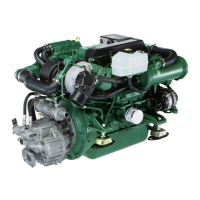Cooling system
61
Freshwater system
The freshwater is circulated via the cooling ducts and
heat exchanger of the engine by a centrifugal pump.
As long as the coolant is cold, the thermostat(s) re-
main closed, preventing the coolant from passing to
the heat exchanger. Instead the coolant flows in a by-
pass duct directly back to the suction side of the
pump. This ensures that the engine rapidly reaches its
working temperature. The thermostats also maintain
proper temperature at low power/load.
Coolant
If a cooling system is to function well, it is very impor-
tant that the coolant is treated correctly so that no
corrosion or lime scale forms in the cooling system.
NOTE! Always use Volvo Penta anti-freeze or anti-
corrosion agent. Both are available in concentrated
form. Mixing with other makes of coolants can impaire
corrosion protection, which may damage the engine or
block the cooling system.
Water quality
Always use clean water that complies with the require-
ments in ASTM D4985 X1.1. If these requirements
are not met, corrosion may occur, which could lead to
impaired cooling performance.
Specification:
Solid particles < 340 ppm
Total hardness < 9.5° dH
Chloride < 40 ppm
Sulphate < 100 ppm
pH value < 5.5 – 9.0
Silica < 20 mg SiO
2
/lit.
Iron < 0.10 ppm
Magnese < 0.05 ppm
Conductivity < 500 µS/cm
Organic content COD
Mn
< 15 mg kMnO
4
/lit.
If the water cannot be cleaned to fullfil the require-
ments de-ionised water or distilled water should be
used. Volvo Penta ready-mixed coolant can also be
used.
Make sure that there is a space of 150 mm (6")
above the filter to permit routing of house to the anti-
siphoning valve.
150 mm
Min 200 mm
(8")
200 mm
(8")
Anti-siphoning valve
The anti-siphoning valve (vacuum valve) should be
fitted in cases where the engine is installed so deep in
the boat that the distance between the exhaust pipe
flange (lower part) and water-line is less than 200 mm
(8"). When correctly fitted the valve prevents
siphoning, which causes water entry into the engine.

